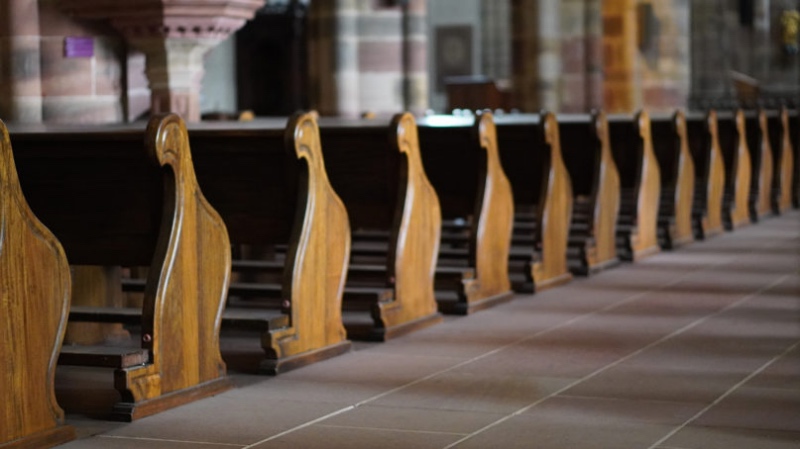
BRONWYN LEA, US-based author of ‘Beyond Awkward Side Hugs: Living as Christian Brothers and Sisters in a Sex-Crazed World’ , says this season of church closures and online gatherings has brought with it opportunities “for even deeper and richer connection than we had before”…
Via RNS
My husband and I moved to the US 16 years ago. We didn’t know a soul in the college town where he would be starting graduate school, and with just six months of marriage under our belts, we barely knew one another either.
But God provided a new family through the local church: An older couple welcomed us into their home to watch the Olympics and eat Thanksgiving with them as if we were their own children, and a whole community of brothers and sisters over the years celebrated the births of our children and prayed us through mini-crises. With them, we would give, grieve and grow in God’s service.

Musicians perform remotely during a Hillsong East Coast online service in the US, on Sunday, 26th April. PICTURE: Video screengrab
Even as our church ties grew stronger, we stayed connected to our families back home, at first via calling cards, then Skype: no more searching for the best rates and punching in endless numbers! A few years later my sisters persuaded me to get a smartphone.
Suddenly, for the first time since high school, I could be in daily contact with my family. The truth is that our constant check-ins – a funny meme here, a video challenge there, a quick call to see the completed art project or first lost tooth – likely provided more daily contact than if we’d lived in the same town.
“With more than a decade of personal long-distance, internet-aided family communication under my belt, I can assure them that not only is it possible to stay connected with family when we don’t see each other in person, but there are opportunities in this season for even deeper and richer connection than we had before.”
Distance had made us more intentional about connection. And technology helped that connection become intimate.
This truth contains lessons for the many churches around the world that have closed down services to help flatten the curve of the COVID-19 trajectory. With more than a decade of personal long-distance, internet-aided family communication under my belt, I can assure them that not only is it possible to stay connected with family when we don’t see each other in person, but there are opportunities in this season for even deeper and richer connection than we had before.
Here are some invitations to community we discovered once we couldn’t meet face to face anymore:
• Social media really does have the power to be social again. Sharing memes, pictures of pets, and community encouragement can take the place of arguments and advertising.
• Teens have new opportunities for leadership and service. Just like my nieces and nephews have come up with new suggestions for things we could do online, the youth in our church have led the way in creating fun TikToks and taking turns to read their favorite scriptures online and share them. Our entire church family is being led in worship in new ways by the youth.
• Online connection can often reach further than in-person connections can. My grandmother hasn’t been able to travel for years, but online connectivity allowed her to join our daily life from the other side of the world. Similarly, people who may not have visited our church in person have been joining online for Sunday worship: We’ve had triple the number of views on YouTube than we’d had for regular in-person attendance. Who knows how God might choose to include those who are far off into his family through this?
• We’re calling one another more. For many people, this is the first time they’ve had a longer-than-two-minute conversation with someone from church in a long time, and it makes us wonder why we’ve fallen out of the habit of phoning someone to catch up.
• We are seeing one another more attentively again. While meeting in small groups via Zoom or Google Hangouts has a bit of a learning curve, there’s something great about actually seeing one another’s faces, rather than worshipping with everyone’s eyes toward the front.
• We are seeing new gifts in others. Perhaps we didn’t know that Natalie had a great singing voice, or Mickey was actually something of a tech ninja in troubleshooting problems. This new crisis is helping us value a broader range of gifts and talents from among our church community.
• Distance calls for thoughtfulness in considering how to include everyone. When our kids were too young to talk on the phone, we recorded little videos of cousins singing “Happy Birthday,” which would then be played again and again. The limits of technology made us pay attention to ways in which we were unwittingly excluding (and thus had to intentionally include) the younger members of the family. Similarly, our church families have an opportunity to rethink how we are reaching the elderly, the hearing impaired, those who live alone and more
The ache of separation is a gift
While it is possible to stay connected – and even grow – in our relationships while we’re apart, the fact remains that it is hard. The longings the Apostle Paul expressed in Thessalonians have a new poignancy as I read them: his longing to be reunited, his concern for how the fledgling church is doing while they’re separated from him. To be together is better, and while we receive the gifts and opportunities of this season – we acknowledge that there is pain and longing in the separation.
There is a gift in this, too. The longing shows that church is not just a weekly routine (or a necessary chore). The reason our current separation hurts is because it matters. Church is more than a holy habit; it’s a holy home, where our family is. The grief at not being together is homesickness of a sort, a reminder that there are people we belong to. Although church can be complicated (as all relationships are), the pangs of longing remind us that we love one another after all.

With churches closed, Christians are being forced to go online to maintain contact. PICTURE: Matthias Böckel/Pixabay/Creative Commons
Church family is real family
The comparison of long-distance relationships with my family of origin and my church family is more than a tidy metaphor. The Biblical truth underlying this comparison is that when we speak of church family, we are describing a relational reality.
Scripture has many metaphors to describe our relationship to God and one another: He is the vine, we are the branches. He is the rock, and we are stones in the temple. Yet, when the Bible speaks of God being our Father and us being his children, it is not using a word picture; it is describing something profoundly true. “Oh, how great the love the Father has lavished on us that we should be called children of God, and that is what we are!” says the Gospel of John.
God is our real Father, and we are really and truly adopted into His family…which makes us real and true brothers and sisters of one another: We are the adelphoi – or, in the Greek, brothers and sisters – of God. The New Testament addresses us this way more than 135 times: It is not a peripheral image but central to the way Scripture calls us to see ourselves.
In this time of separation, we are ourselves a family in Christ, brothers and sisters who are together-while-apart, and the invitation for us to connect and grow is ours for the taking.
Bronwyn Lea is the author of Beyond Awkward Side Hugs: Living as Christian Brothers and Sisters in a Sex-Crazed World. She lives with her family in Northern California, where she serves on the pastoral staff of her local church. Connect with her on Facebook, Twitter, Instagram and through her monthly-ish newsletter.





